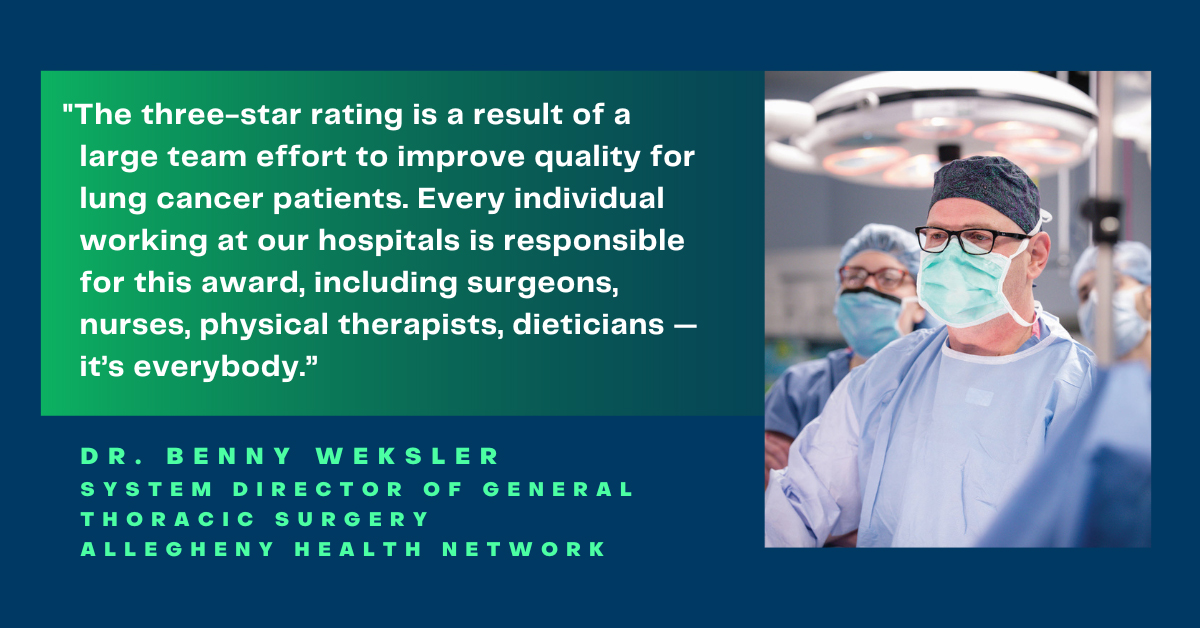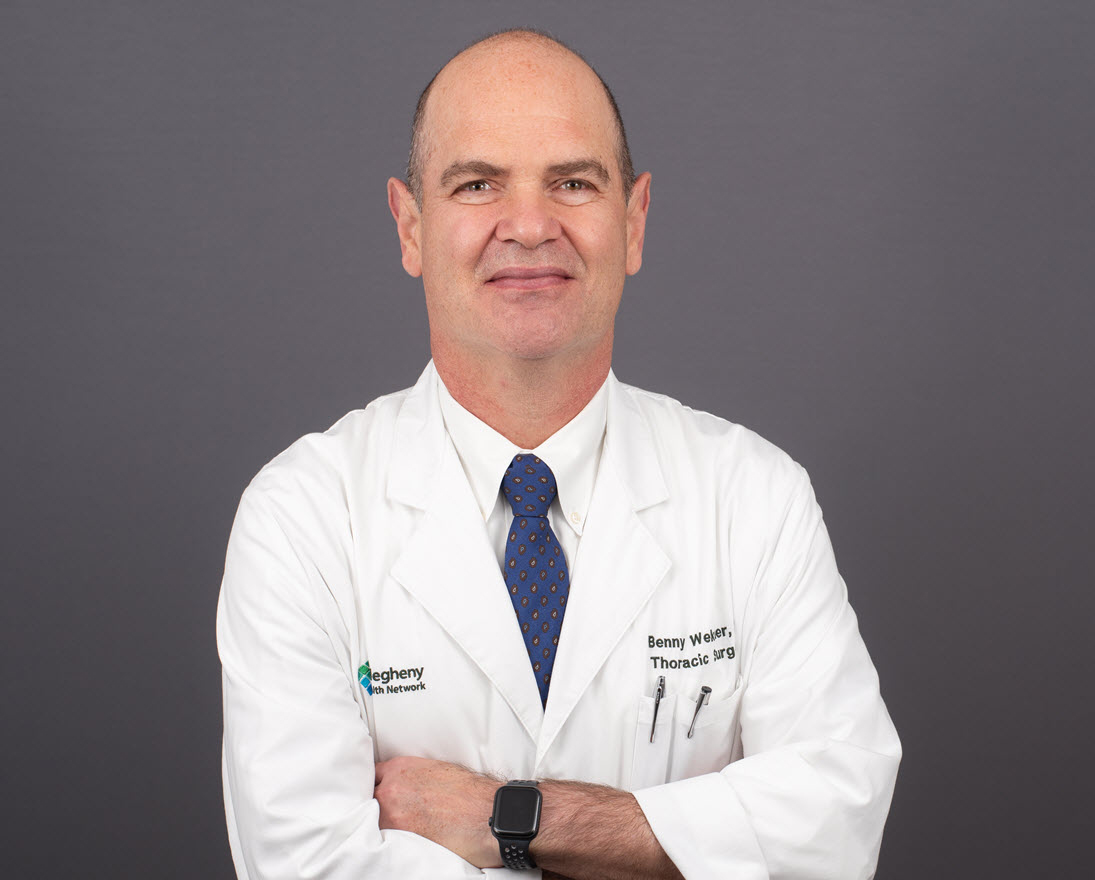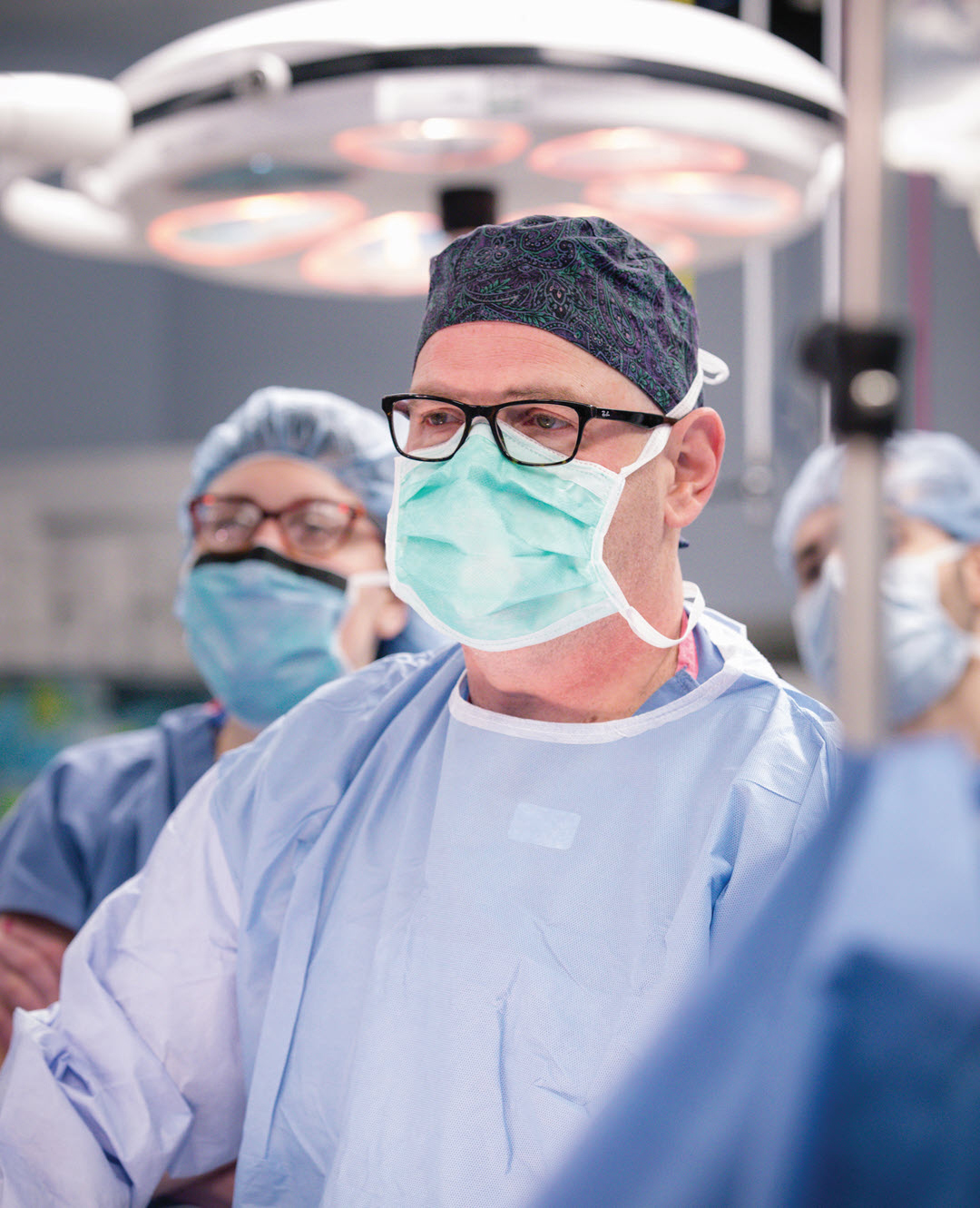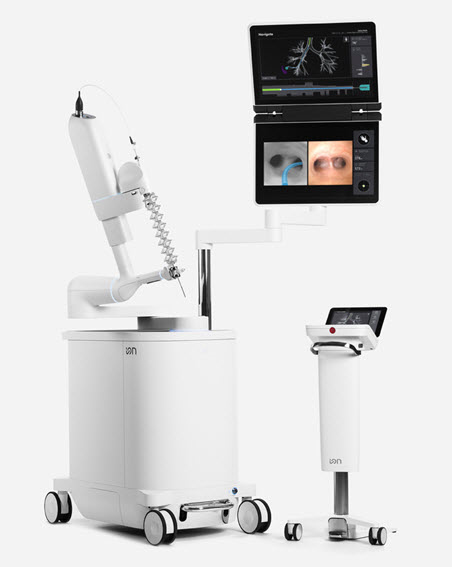Editor's Update: This article was first published November 20, 2020. It was most recently reviewed and updated May 3, 2023, including adding the short KDKA radio interview below:

Benny Weksler, MD, a nationally recognized thoracic surgeon and expert in robotic and minimally invasive surgery, has been System Director of General Thoracic Surgery at Allegheny Health Network (AHN) since 2018. He says AHN has one of the nation’s most notable programs for minimally invasive lung cancer care: “We've shown again and again that a minimally invasive approach is better for patients, and can also decrease costs because length of stay is shorter and fewer patients are going to an intensive care unit.”
He adds that AHN's thoracic surgery programs at Allegheny General Hospital and Forbes Hospital have also consistently earned a distinguished three-star rating from the Society of Thoracic Surgeons (STS) for patient care and lung cancer resection outcomes, placing them among the top cardiothoracic surgery programs in the U.S. and Canada.
Rather than focus solely on treatment, however, Dr. Weksler suggests discussing the full continuum of lung cancer care. Advances in diagnosis and treatment are improving survival rates and quality of life for patients, he explains, but lung cancer screening and early detection remain critically important.

Dr. Benny Weksler, System Director of General Thoracic Surgery at Allegheny Health Network.
Emily Adamek: Who is the high-risk population for lung cancer?
Dr. Benny Weksler: Long-term smokers. When you look at the current CDC screening recommendation guidelines, it’s anyone between age 50 and 80 who has smoked the equivalent of a pack of cigarettes a day for 20 years. Western Pennsylvania and West Virginia have high numbers of smokers, so the focus on screening is particularly important in the AHN region.
Emily Mashore: Are there any other risk factors that might lead a doctor to recommend lung cancer screening?
Dr. Benny Weksler: Occasionally, patients that have a strong family history of lung cancer or those exposed to significant levels of radon are considered for screening, but lung cancer is caused by smoking about 90% of the time.
Emily Mashore: What is involved in lung cancer screenings?
Dr. Benny Weksler: AHN utilizes low-dose computed tomography (LDCT) to screen patients for lung cancer. The radiation dose is very low, equivalent to a chest X-ray. The screening only takes about 15 minutes.
Emily Adamek: For those who are eligible, why is it so important to get screened?
Dr. Benny Weksler: Screening can detect nodules early, then we can biopsy them, and if necessary, do minimally invasive surgery and get people back to their lives. Over 80% of people who get screened and found to have lung cancer early can be cured. In people who are not screened, about 60% of lung cancer cases are in patients with more advanced disease — stage IV metastasis, meaning the cancer has spread to other parts of the body.
Emily Adamek: So don’t wait until you start exhibiting symptoms to get screened, right?
Dr. Benny Weksler: Correct. Lung cancer is silent. When it’s no longer silent, it’s usually advanced and can’t be treated as easily or as successfully as it can with early detection.
Emily Adamek: What would you say to help convince someone who is eligible but still on the fence about getting screened?
Dr. Benny Weksler: I would tell them that it’s better to know. I understand that it’s scary, but the possibility of detecting this disease early improves your chances of living longer. That is proven and clear.

Emily Adamek: If something abnormal is discovered during a screening, what are the next steps?
Dr. Benny Weksler: If we find a nodule, the next step is to discuss the findings in a multidisciplinary setting — a weekly conference we have that includes surgeons, medical oncologists, pulmonologists, and relevant medical professionals.
Our joint decision about what to do next falls along a spectrum between a period of observation and immediately ordering a biopsy. Our job in the conference is to figure out which nodules have a higher chance of being malignant before doing a biopsy. We want to make sure we’re not being overly aggressive with patients by operating on every single benign tumor because, quite frankly, if you look at those screenings, the majority of nodules are not malignant. When we’re not sure, we can monitor; if the nodules increase in size slightly, that raises the index of suspicion, and then we go to biopsy.Emily Adamek: Are there different biopsy procedures? Where does robotic-assisted biopsy fit in?
Dr. Benny Weksler: Sometimes, albeit rarely, we do a percutaneous needle biopsy, or even surgery for diagnosis. But primarily at AHN we now use the Ion endoluminal system, a robotic-assisted technology for performing minimally invasive lung biopsies. It uses an ultra-thin catheter, giving it maneuverability and stability to reach peripheral areas in the lung that can’t be accessed with traditional biopsy technology. AHN was the first in the region to use this type of biopsy system. At last count, 98.7% of AHN’s surgeries for early stage lung cancer were minimally invasive, so this has really decreased the need for more invasive procedures.
Emily Adamek: What are the main advantages of the Ion system from a patient’s perspective, and from a clinician's perspective?
Dr. Benny Weksler: From a patient’s perspective, the biopsy with the Ion is painless and they can go home that same day. It only takes about 20 to 30 minutes to complete the biopsy.
For a clinician, the Ion has the smallest diameter catheter of all the tools in the market, so it can reach much farther in the lung. Even small nodules on the outside of the lung can be reached. It’s also a relatively easy procedure to perform — training is not extensive.
Additionally, for the health care system, we believe that the Ion decreases total costs, because we need to do fewer surgical procedures in order to show whether or not a patient has cancer.
Emily Adamek: You said AHN was the first system in this region using Ion. What is important about how Ion works compared to other options?
Dr. Benny Weksler: First, I would emphasize the safety profiles. These biopsies have very few complications as opposed to CAT scan-guided biopsies with needles that can have anywhere from 10% to 25% pneumothorax. That means there is air between the lung and the chest that needs to be drained, often requiring the patient to stay in the hospital.
The Ion is a form of robotic navigational bronchoscopy. Other types of navigational bronchoscopy use electromagnetic positioning. The problem there is that any metal close to the device changes the electromagnetic field. When I used to do navigational bronchoscopy with electromagnetic fields, we’d bring the X-ray machine down and we could see the targets changing position on the screen. The Ion system uses completely different technology — no other competitor has it. It’s based on a fusion of computed tomography (CT) scan imaging and the shape of the catheter. The computer knows that, depending on the shape of the catheter, it will be in a certain position on the overlay CT. The positioning is not influenced by external factors, so there’s no outside interference.
Emily Adamek: What happens when someone has a positive diagnosis for lung cancer? Where would robotics be part of treatment?
Dr. Benny Weksler: Patients with a positive diagnosis get a PET-CT scan to make sure we staged the disease appropriately. If it confirms that the lung cancer is early stage, then we do minimally invasive surgery. Depending on the location and size of the nodule, we can do a lobectomy, which is removing part of the lung — there are two lobes on the left side and three on the right side.
If a person is diagnosed early and the nodule is in a favorable position, sometimes you only have to remove 10% to 15% of the lung, meaning the patient maintains more lung capacity. We do this procedure with the Da Vinci robotic system. After the procedure, the majority of patients are up and about the next day. The median length of stay in the hospital after the procedure is two days.
Emily Adamek: How do robotic surgery options compare to traditional surgery?
Dr. Benny Weksler: The traditional way of taking care of lung cancer has been what we call a thoracotomy. That requires a large incision between the ribs and then actually cracking the ribs open to do the surgery. A minimally invasive approach is better for patients and decreases costs because length of stay is shorter, fewer patients have to be in an ICU, and there is improved quality of life. Even patients who may need chemotherapy after surgery are typically able to tolerate the chemo better because of the less invasive approach.
Emily Mashore: Because of your success with surgery outcomes, the Society of Thoracic Surgeons has awarded your team a distinguished, three-star rating multiple times. Congratulations! What qualifications are needed to earn three stars?
Dr. Benny Weksler: The ratings were established after the Society of Thoracic Surgeons began collecting data on surgeries performed by member institutions in 1989. This information included pre-surgery information (stage of the tumor, sickness level of the patient) and outcomes after surgery (complications, hospital stay time, morbidity rates). A risk model has been created acknowledging that some patients have higher risks for complications than others.
Today, the STS compares program-specific data and outcomes to the National Inpatient Sample (NIS), best representing national outcomes. The NIS database includes about 8 million inpatient hospital discharge abstracts that broadly represent hospitalized patients in the U.S. and national lung cancer resection outcomes.
One-star ratings are for programs with averages below the STS average. Two-star ratings meet the STS average, and about 80% of programs earn that recognition. Three-star ratings are for programs that are above the STS average, which is where we’ve been consistently. Only 7% to 10% of programs across the country have earned three stars, and we are the only group in Pennsylvania to receive that designation. You can find us on the STS website under “McGinnis Associates” where our Allegheny General, Forbes, and Wexford hospitals are recognized.
Emily Mashore: That’s amazing. How would you say the three-star rating reflects patient care at AHN?
Dr. Benny Weksler: To be honest, the three-star rating is a result of a large team effort to improve quality for lung cancer patients. Every individual working at our hospitals is responsible for this award, including surgeons, nurses, physical therapists, dieticians — it’s everybody. Everyone plays a role.
The three-star rating just reaffirms our commitment to our approach to performing successful surgeries and recognizing pre-operative risk factors so that we can provide appropriate care to our patients.

The Ion robotic-assisted endoluminal platform for minimally invasive peripheral lung biopsy. Photo courtesy of Intuitive via Intuitive.com.
Emily Adamek: Because of technology and other advances, how has the continuum of care for lung cancer — screening to diagnosis to treatment — changed compared to what patients experienced 20 years ago?
Dr. Benny Weksler: For starters, 20 years ago we didn’t even have a screening program. So, when patients came in with lung cancer, they were often symptomatic — for example, they might be spitting blood or have a significant cough. That usually meant cancer was in the late stages and might not even be operable. 20 years ago, there was almost no minimally invasive surgery, so everyone was treated with invasive surgery.
In recent years, lung cancer mortality has gone down significantly. I feel like for the first time in my career, we’ve made a dent. The needle is finally moving in the right direction. The majority of the mortality decrease can be attributed to three factors: less people are smoking; we have better screening; there is better treatment available for patients with advanced disease.
Emily Adamek: So, although lung cancer is still the deadliest cancer, the overall prognosis has improved?
Dr. Benny Weksler: There is little doubt that with earlier detection, lung cancer patients are surviving longer. For example, the survival rate for someone with stage 1A is over 85% for five years. And that rate includes elderly patients who are dying of other things, not just lung cancer. The cancer-specific mortality is even lower.
Emily Adamek: Looking ahead, what further improvements are you excited about?
Dr. Benny Weksler: In the U.S., only about 4% of people who are eligible to be screened for lung cancer are getting screened. My hope for the future is to increase that number. As excited as I am to also have increasingly amazing technology like the Ion and Da Vinci systems, early detection is critical, and the key to that is getting more of the eligible people to get screened.